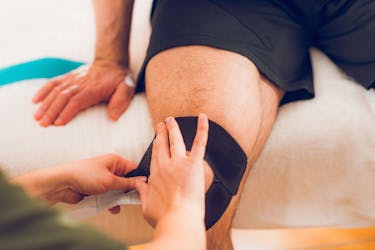Manual Therapy
Manual therapy is a hands-on treatment by clinicians to treat muscle aches, joint pain, and limited range of motion. It encompasses a variety of techniques including soft tissue mobilization of muscles, specific joint mobilization, and joint manipulation.
The three most notable forms of manual therapy are:
- Manipulation is the application of a rapid force into a joint(s). Manipulation is often associated with an audible popping sound called cavitation.
- Mobilization is a slower, more controlled process of articular and soft-tissue stretching intended to improve joint mobility.
- Massage is typically the repetitive rubbing, stripping or kneading of muscle and fascia tissues to facilitate healing.
Manual therapy has been proven to be an important part of an overall conservative treatment plan for a variety of conditions including:
- Adhesive capsulitis
- Shoulder impingement
- Shoulder stiffness/limited range of motion
- Tennis elbow
- Golfers elbow
- Pinched nerves
- Limited joint range of motion
- Capsule tightness
- Postsurgical stiffness
- Much more.
Manual therapy is typically part of a complete treatment plan that is customized for your specific needs. Give us a call to learn how we can incorporate manual therapy into your rehabilitation program.
Kinesio Taping
Kinesio® Tape was invented by Japanese chiropractor, Dr. Kenzo Kase, in 1979, as a result of much research in kinesiology, the science behind muscular and skeletal movement. Dr. Kase developed both the method and the first elastic therapeutic tape, Kinesio Tape. He also founded Kinesio, the company behind the product, in the 1980s, and formed the Kinesio Taping Association (KTA) in 1984. Kinesio USA, LLC, began operating in 1994, headquartered in Albuquerque, New Mexico.
The Kinesio Taping® (KT) Method is the rehabilitative application of Kinesio® Tape to facilitate the body's natural healing process while providing support and stability to muscles and joints without restricting the body's range of motion as well as providing extended soft tissue manipulation to prolong the benefits of manual therapy administered within the clinical setting.
According to Dr. Kaze, the four major functions of Kinesio Taping® are:
- Supporting the muscle: Proper taping improves the muscle's ability to contract even when it's weakened, reduces a feeling of pain and fatigue, and protects the muscle from cramping, over-extension and over-contraction.
- Removing congestion to the flow of body fluids: Kinesiology tape improves blood and lymphatic circulation and reduces inflammation and excess chemical buildup in the tissue.
- Activating the endogenous analgesic system: "Endogenous" refers to something that is self-originating, and calling something "analgesic" means that it can relieve pain in a conscious person. So, this requirement means that the tape must facilitate the body's own healing mechanisms, a central focus in chiropractic medicine.
- Correcting joint problems: The goal is improving range of motion and adjusting misalignments that result from tightened muscles.
These four functions drive the technology behind the tape, which features a very thin, highly elastic porous cotton top side, that lets the skin breathe and an underside of sticky water-repellant, medical-grade acrylic adhesive, which further supports the muscles and connective tissues. By targeting different receptors within the somatosensory system, Kinesio® Tape alleviates pain and facilitates lymphatic drainage by microscopically lifting the skin, which reduces swelling and inflammation. Kinesio® Tape can be applied in hundreds of ways and has the ability to re-educate the neuromuscular system, reduce pain and inflammation, enhance performance, prevent injury and promote good circulation and healing, and assist in returning the body to homeostasis (internal conditions remain stable and relatively constant).
Graston
Graston Technique® effectively breaks down scar tissue and reduces inflammation that causes pain and restricted mobility. Used by a physical and occupational therapist, hand therapists, chiropractors and athletic trainers, the stainless steel instruments comb over and "catch" on fibrotic tissue, which immediately identifies areas of restriction. The instruments enable clinicians to treat soft tissue lesions with the depth, pressure and specificity necessary to affect the condition at the site of the pain, as well as following the kinetic chain to find and treat the cause. Once the tissue dysfunction has been identified, the instruments break up the scar tissue so it can be absorbed by the body.
By incorporating stretching, strengthening and ice in the treatment and rehab process, clinicians can rebuild the soft tissue injury into healthy functioning tissue.
Graston Technique® is clinically proven to achieve quicker and better outcomes in treating:
- Achilles Tendinosis/itis
- Carpal Tunnel Syndrome
- Cervical Sprain/Strain (Neck Pain)
- Fibromyalgia
- Lateral Epicondylosis/itis (Tennis Elbow)
- Lumbar Sprain/Strain (Back Pain)
- Medial Epicondylosis/it is (Golfer’s Elbow)
- Patellofemoral Disorders (Knee Pain)
- Plantar Fasciitis (Foot Pain)
- Rotator Cuff Tendinosis/itis (Shoulder Pain)
- Shin Splints
- Trigger Finger
Historically, the Graston Technique® has had positive outcomes in 75-90 percent of all conditions treated. It is equally effective in restoring function to acute and chronic injuries, and pre and postsurgical patients.
You can learn more about the Graston Technique® at www.grastontechnique.com.
MyoFascial Decompression
Myofascial Decompression (Cupping) is a practice that involves placing cups on the skin to create suction. This practice dates back over 2,000 years but has received recent attention due to its use by world-class athletes for injury relief.
It’s believed that the effect of suction on the skin helps increase blood flow and promotes healing; however, the way in which cupping may have an effect on the body is unclear.
In a PLOS One* study, researchers concluded that cupping could be effective in treating the pain and disability associated with chronic neck pain and chronic low-back pain in the short term.
Cupping is generally safe for healthy people when performed by one of our trained health professionals.
Some of the side effects like bruising and soreness are possible.
Ask your physical therapist how cupping might help you.
Cupping is a helpful alternative treatment for some. Please share your complete health history with your therapist and they will discuss the benefits and possible side effects of cupping to make sure it is right for you.
Call Us Today for More Information
*PLOS One is a peer-reviewed open access scientific journal published by the Public Library of Science.
Walnut Creek
(925) 930-6680
San Ramon
(925) 855-1733





